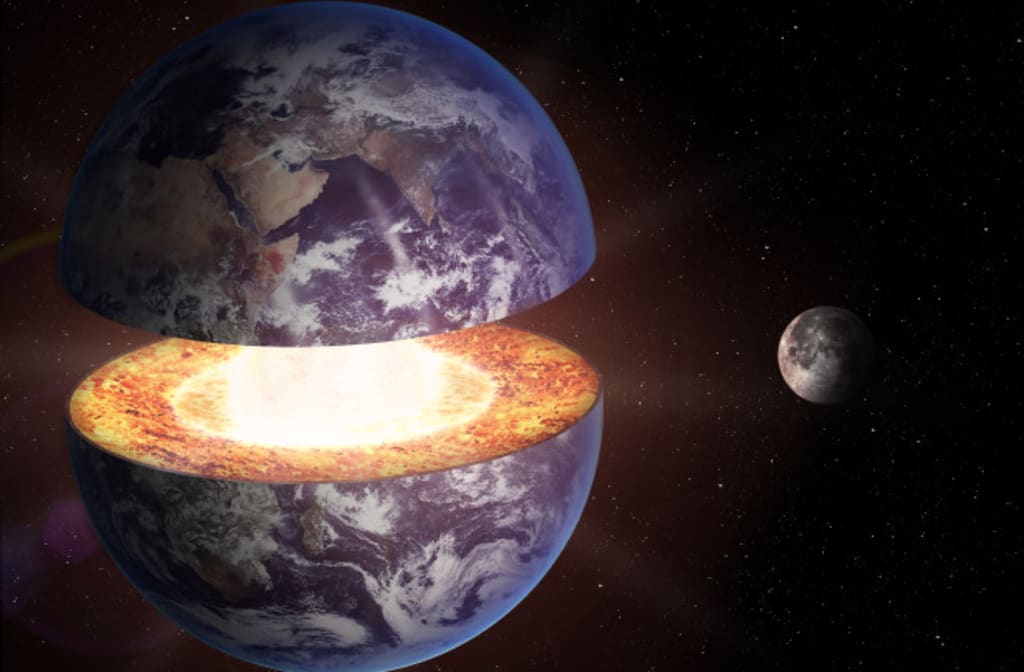WHAT IS INSIDE EARTH
"Unveiling Earth's Hidden Depths: A Journey into the Layers of Our Dynamic Planet"

The Earth is composed of several layers, each with distinct properties and characteristics. From the outermost layer to the innermost, these layers are:
Crust: The Earth's crust is the outermost layer and is relatively thin compared to the other layers. It includes both the continental crust (beneath land masses) and the oceanic crust (beneath the ocean floor). The crust is composed of various rocks and minerals.
Mantle: Below the crust lies the mantle, which extends to a depth of about 2,900 kilometers (1,800 miles) beneath the Earth's surface. The mantle is mainly composed of solid rock that can flow over geological timescales. It is divided into the upper mantle and the lower mantle.
Outer Core: Below the mantle, the outer core extends from a depth of about 2,900 kilometers (1,800 miles) to 5,150 kilometers (3,200 miles). The outer core is composed of liquid iron and nickel, and its movement is responsible for the generation of Earth's magnetic field through the geodynamo process.
Inner Core: The Earth's innermost layer is the inner core, which extends from a depth of about 5,150 kilometers (3,200 miles) to the center of the Earth at approximately 6,371 kilometers (3,959 miles). The inner core is primarily composed of solid iron and nickel due to the immense pressure at this depth, even though the temperature is extremely high.
Continental and Oceanic Crust Differences: The oceanic crust is denser and thinner than the continental crust, primarily composed of basaltic rocks. The continental crust is less dense and mostly composed of granitic rocks.
Seismic Waves: use seismic waves generated by earthquakes to study the Earth's interior. The behavior of these waves provides valuable information about the composition and structure of the different layers.
Plates and Plate Tectonics: The theory of plate tectonics explains the movement of Earth's lithospheric plates. Plates can collide, move apart, or slide past each other, causing various geological features and events.
Mohorovičić Discontinuity (Moho): The boundary between the Earth's crust and mantle is marked by the Mohorovičić discontinuity, commonly known as the Moho. It was named after the Croatian seismologist Andrija Mohorovičić, who first identified this seismic boundary.
The Moho is typically located at depths ranging from 5 to 10 kilometers (3 to 6 miles) beneath the ocean floor to 30 to 50 kilometers (18 to 31 miles) beneath continental landmasses.
Asthenosphere: The asthenosphere is a partially molten and ductile region in the upper mantle, situated just below the lithosphere (the rigid outer layer of the Earth). It plays a crucial role in the movement of tectonic plates.
Subduction Zones: Subduction zones occur where one tectonic plate is forced beneath another. This process is responsible for deep ocean trenches, volcanic arcs, and seismic activity.
The subduction of oceanic plates into the mantle leads to the recycling of material and influences global geochemical cycles.
Hotspots: Hotspots are stationary upwellings of magma that result from mantle plumes. These plumes create volcanic islands or features, such as the Hawaiian Islands.
The movement of tectonic plates over hotspots can create chains of volcanic islands, providing insights into plate motion.
Earth's Magnetic Field Reversals: The Earth's magnetic field has undergone numerous reversals throughout its history, where the magnetic north and south poles switch places. This phenomenon is recorded in the alignment of minerals in rocks, providing a geological record of magnetic field changes.
Mineral Composition: The composition of minerals in the Earth's interior varies with depth and pressure. At extreme depths, high-pressure polymorphs of common minerals may exist, altering their crystal structures.
Core Formation: The formation of the Earth's core is thought to be a result of differentiation during the early stages of the planet's formation. Dense metallic elements like iron and nickel migrated towards the center, forming the core, while lighter elements remained in the outer layers.
Geoneutrinos: Geoneutrinos are subatomic particles produced by radioactive decay in the Earth's interior. Detecting geoneutrinos provides information about the abundance of radioactive elements in the planet's composition.
In conclusion, Earth's interior is a dynamic and intricate system composed of several layers, each with distinct properties and behaviors. From the solid but mobile crust to the liquid outer core generating the magnetic field, the Earth's interior plays a crucial role in shaping our planet's geology and influencing natural phenomena. Ongoing scientific research, utilizing methods such as seismic studies, has deepened our understanding of the complexities within the Earth.
The interactions between the lithosphere, asthenosphere, mantle, and core contribute to geological processes, including plate tectonics, volcanic activity, and the generation of Earth's magnetic field. The study of Earth's interior not only provides insights into the planet's past and present but is also essential for predicting and understanding natural disasters, resource exploration, and unraveling the mysteries of planetary formation and evolution.
As technology advances and new exploration methods emerge, our knowledge of Earth's interior continues to expand, enhancing our ability to comprehend the intricate mechanisms that shape our dynamic planet. The Earth's interior serves as a captivating realm for scientific inquiry, offering a deeper understanding of the forces that have sculpted the world we inhabit today.
About the Creator
Enjoyed the story? Support the Creator.
Subscribe for free to receive all their stories in your feed. You could also pledge your support or give them a one-off tip, letting them know you appreciate their work.






Comments (2)
https://vocal.media/history/a-hoax-or-horror Here it is, if you wanna take peak
ooo I just shared a post on some thoughts regarding the idea of the supernatural location of Hell in the center of the earth. Nice work!